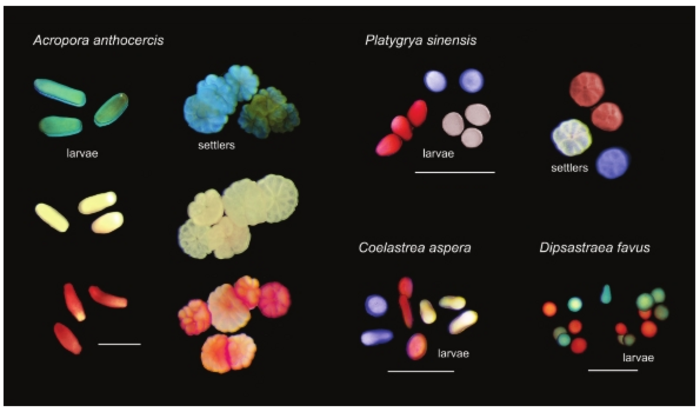According to research reported on December 6th, 2022, in the open access journal PLOS Biology by Christopher Doropoulos and George Roff from CSIRO Oceans & Atmosphere, Australia, a new, low-cost staining method permits visual tracking of coral larvae as they disperse and settle in coral reefs.
 Representative images of free-swimming and newly metamorphosed larvae (Nile blue, unstained, neutral red) from Acropora anthocercis, Platygyra sinensis, Coelastrea aspera, and mixed Nile blue and neutral red stained Dipsastraea favus larvae. White scale bars = 1 mm. Image Credit: Doropoulos C and Roff G, 2022, PLOS Biology, CC-BY 4.0
Representative images of free-swimming and newly metamorphosed larvae (Nile blue, unstained, neutral red) from Acropora anthocercis, Platygyra sinensis, Coelastrea aspera, and mixed Nile blue and neutral red stained Dipsastraea favus larvae. White scale bars = 1 mm. Image Credit: Doropoulos C and Roff G, 2022, PLOS Biology, CC-BY 4.0
Corals are marine invertebrates that are important for conservation because of their ability to construct reefs, which provide habitat for several other marine organisms. However, they are affected by climate change, pollution, and other human activities. Since they can produce trillions of microscopic larvae, it is difficult to follow their movements because they can disperse up to 100 km and settle on the seabed.
To test a new approach for monitoring coral larvae, the researchers retrieved approximately 3000 larvae from lab-reared corals of two species (Acropora spathulata and Platygyra daedalea) and incubated them with one of four colored dyes at varying intensities. They discovered that two dyes, neutral red and Nile blue, effectively dyed coral larvae while having no effect on their survival and settlement.
In the lab, these two dyes effectively dyed 98 % of the larvae of four additional coral species. They collected eggs from wild spawning corals on the Great Barrier Reef, maintained them in larval pools in the Lizard Island lagoon, and stained 10,000 larvae with Nile blue dye to put the innovative method to the test in the field. Researchers discovered the successful settling of stained larvae on lagoon tiles.
The staining approach allows scientists to investigate dispersal in huge numbers of coral larvae in a fast, simple, and non-toxic manner. It is also inexpensive, with 100,000 larvae colored for less than a dollar.
According to the scientists, the different color dyes might be used to distinguish between groups or species, making the technology suitable for conservation planning, behavioral ecology, and reef restoration trials in laboratory and field studies.
We have developed a novel method for coloring large numbers of coral larvae (millions to billions). Our method allows for immediate differentiation and visual tracking of coral larvae from dispersal to settlement, and will facilitate a wide range of de novo studies of larval behavior and ecology.
Christopher Doropoulos, CSIRO Oceans & Atmosphere
Journal Reference:
Doropoulos, C. & Roff, G. (2022) Coloring coral larvae allows tracking of local dispersal and settlement. PLoS Biology. doi.org/10.1371/journal.pbio.3001907.